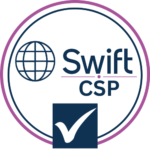 Swift Compliance
Swift Compliance
The SWIFT network is vital for secure international financial transactions, and ensuring compliance with SWIFT’s security requirements is crucial to prevent fraud and maintain operational integrity. SWIFT’s Customer Security Programme (CSP) sets specific controls that financial institutions must implement to safeguard their SWIFT-related infrastructure. Here are the key steps for effectively monitoring SWIFT compliance:
1. Conduct Regular Security Audits
Regular audits are essential for assessing compliance with SWIFT’s CSP controls. These audits evaluate security controls, network configurations, and data handling practices, helping identify areas that may require enhancement to meet SWIFT’s standards.
2. Implement Strong Access Controls
Access to SWIFT systems should be tightly controlled. Multi-factor authentication (MFA), role-based access, and monitoring of user permissions help ensure that only authorized personnel can access SWIFT environments, reducing the risk of unauthorized activity.
3. Secure SWIFT-Related Infrastructure
SWIFT compliance requires securing infrastructure elements, including firewalls, network segmentation, and encryption. Organizations should regularly update these security measures and perform vulnerability assessments to keep SWIFT-related systems protected from cyber threats.
4. Monitor Transaction Activity for Anomalies
Organizations must monitor SWIFT transactions to detect unusual patterns that may indicate fraudulent activity. Advanced monitoring tools and real-time analysis of transaction data help in quickly identifying and responding to suspicious activity.
5. Conduct Penetration Testing
Regular penetration testing is crucial for identifying potential vulnerabilities within SWIFT-related infrastructure. By simulating cyberattacks, organizations can assess the robustness of their security defenses and improve their ability to withstand real threats.
6. Establish a Strong Incident Response Plan
SWIFT compliance requires a documented incident response plan that details how to handle security incidents within SWIFT systems. The plan should cover steps for identifying, containing, and remediating security incidents, as well as communication protocols for notifying SWIFT and relevant authorities if needed.
7. Train Employees on SWIFT Security Standards
Staff must be trained on SWIFT’s CSP controls, including best practices for secure access, data handling, and incident reporting. Regular training reduces the likelihood of human error, ensuring that employees can contribute to SWIFT security efforts effectively.
8. Document Compliance Measures and Incident Logs
SWIFT compliance involves maintaining detailed records of security practices, audits, and incident responses. Proper documentation not only supports SWIFT compliance validation but also provides essential records for internal and external audits.
Conclusion
Ensuring compliance with SWIFT standards is an ongoing commitment that requires consistent security measures, regular monitoring, and employee awareness. By following these key steps, financial institutions can safeguard SWIFT transactions, protect against fraud, and maintain trust within the global financial network.

 Swift Compliance
Swift Compliance